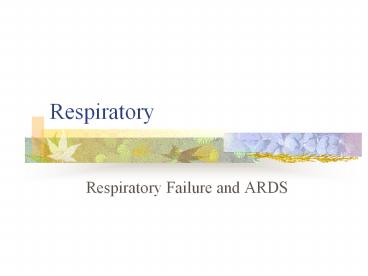Respiratory - PowerPoint PPT Presentation
1 / 31
Title:
Respiratory
Description:
Respiratory Respiratory Failure and ARDS Normal Respirations Respiratory Failure Not a disease process, sign of severe dysfunction Lungs unable to oxygenate blood ... – PowerPoint PPT presentation
Number of Views:177
Avg rating:3.0/5.0
Title: Respiratory
1
Respiratory
- Respiratory Failure and ARDS
2
Normal Respirations
3
Respiratory Failure
- Not a disease process, sign of severe dysfunction
- Lungs unable to oxygenate blood remove CO2
- Alveolar ventilation is inadequate to meet the
bodys need - Commonly defined in terms of ABGs
- PO2 of less than 50 mmHg
- PCO2 greater than 50 mmHg
- Arterial pH of less than 7.35
4
Respiratory failure affect on
acid-base balance
- 1. Hypoxemia resp failure is failure of
oxygenation. - PO2 significantly reduced and PCO2 is at or below
normal - Metabolic acidosis results from tissue hypoxia
- 2. Hypercapnia resp failure results from
hypoventilation. - PCO2 rises rapidly and resp acidosis develops
- PO2 drops more slowly
5
Causes of respiratory failure (p.1157)
- Impaired ventilation
- Impaired diffusion
- Ventilation-perfusion mismatch (VQ)
- COPD most common cause of resp failure
6
(No Transcript)
7
Common manifestations/complications of
respiratory failure
- Hypoxemia
- Hypercapnia
- Underlying disease process symptoms (p. 1157)
8
Cyanosis
9
(No Transcript)
10
Therapeutic interventions for Resp Failure
- Diagnostic tests- ABGs ETCO2 chest X-ray
- Main treatment- correct underlying cause
restore adequate gas exchange in lung - Elevate HOB
- Medications
- Oxygen therapy (O2 sat 90 PaO2 60 mmHg)
- Airway management
11
Tracheotomy
12
Endotracheal tube
13
Endotracheal tube
14
Make sure airway attached to lungs
15
Therapeutic interventions cont.
- Mechanical ventilation
- Adeq gas exchange tissue perfusion
- Criteria to put on
- RR gt 35-45
- pCO2 gt45
- pO2 lt50
16
Mechanical ventilation cont
- Types
- Modes
- PEEP CPAP
- Ventilator settings- including alarms
- Complications
- Ventilate one lung
- Nosocomial pneumonia
- Barotraumas
- Cardiovascular
- Gastrointestinal
17
Nursing assessment specific to
respiratory failure
- Health history
- Physical exam
18
Pertinent nursing problems and interventions
specific to respiratory failure
- Impaired spontaneous ventilation
- Ineffective airway clearance
- Anxiety
- Home care
19
Acute respiratory distress syndrome- ARDS
- Syndrome, sudden progressive acute resp
failure- not primary - Alveolar capillary membranes damaged more
permeablegt noncardiac pulmonary edema
progressive refractory hypoxemia
20
Pathophysiology of ARDS- Stages
- Refer to BB course documents Module 2 for video
- Page 1170-1 illustrations of stages
- Initiation of ARDS onset pulmonary edema
alveolar collapse end-stage ARDS
21
surfactant keeping alveoli open
22
(No Transcript)
23
Common manifestations/complications
of ARDS
- Symptoms develop 24-48 hrs after initial insult
- Early symptoms
- Later symptoms
- Hallmark sign- progressive refractory hypoxemia
- Noncardiac pulmonary edema
24
Therapeutic interventions for ARDS
- Diagnostic tests
- ABGs- hypoxemia
- Chest X-ray- snow storm effect
- Pulmonary function tests
- Hemodynamic monitoring
25
Therapeutic intervention for ARDS cont.
- Medications
- Mainstay of treatment---Mechanical ventilation
with intubation - Correct underlying condition
- Fluid replacement keep vascular volume
- Nutrition positive protein balance
- Heparin prevent thrombothebitis
- Proning
26
Independent Lung Ventilation
27
Prone Device
28
Benefits to Proning gt
29
Nursing assessment specific to ARDS
- Health history
- Physical exam
30
Pertinent Nursing problems and interventions
for ARDS
- Decreased cardiac output
- Ineffective airway clearance impaired tissue
perfusion imbalance nutrition less than body
requirements risk for infection - Dysfunctional ventilatory weaning response
- Home care
31
(No Transcript)































